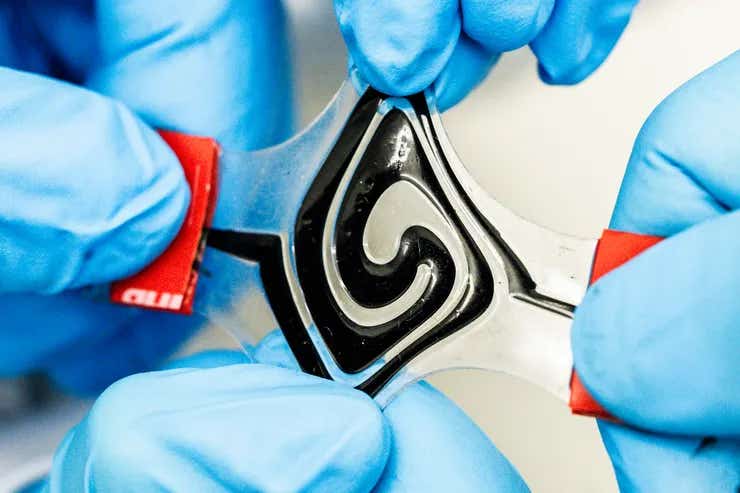Scientists create fluid batteries that stretch without losing power
Soft and flexible batteries with fluid electrodes could soon power future wearable technology, transforming comfort and sustainability.

Researchers developed soft, stretchable batteries using sustainable fluid electrodes. (CREDIT: Thor Balkhed)
Today’s wearable technology like smartwatches, hearing aids, and fitness trackers rely on rigid, bulky batteries. While these devices have become common, future wearables promise even greater convenience.
Electronic skin patches, implantable medical sensors, e-textiles, and soft robots could soon be part of daily life. But their usefulness depends heavily on batteries that can match their flexible forms.
Current battery designs face a major obstacle. To increase battery life, designers typically add more active materials. But adding these materials makes electrodes thicker, stiffer, and less flexible. As a result, these rigid components reduce comfort and limit the device’s ability to move naturally with the body.
Researchers at Linköping University have tackled this longstanding challenge with an innovative approach. They developed batteries using fluid electrodes rather than solid ones. This allows batteries to bend, twist, and stretch without sacrificing energy storage capacity.
From Solid to Fluid Electrodes
At the heart of conventional battery designs is a solid electrode composed of rigid active materials bound tightly together. While these electrodes effectively store energy, their stiffness leads to limited flexibility. Previous solutions tried softer materials or complex shapes but didn’t solve the basic conflict between battery capacity and flexibility.
To address this, Linköping’s Laboratory of Organic Electronics turned solid electrodes into fluids. They developed "electrofluids"—thick, toothpaste-like substances containing tiny particles of electrically active materials suspended in an electrolyte. Unlike solid electrodes, these fluids don’t depend on rigid structures. Instead, their strength and flexibility come from their viscosity—the thickness of the fluid—rather than hardness or stiffness.
Assistant professor Aiman Rahmanudin, who led the research, explained, “The texture is a bit like toothpaste. You could even use it in a 3D printer to shape the battery however you want. This opens up possibilities for entirely new types of devices.”
Related Stories
Because fluid electrodes easily flow into any shape, the battery can be integrated seamlessly into devices. This approach solves the dilemma between battery size and flexibility, as Rahmanudin noted: “We’ve solved the problem, and we’re the first to show that battery capacity doesn’t have to mean increased rigidity.”
Sustainable Materials for a Greener Battery
Beyond flexibility, sustainability was another key goal for the researchers. Many traditional battery materials, such as rare metals, are environmentally harmful and limited in supply. Producing these materials typically involves destructive mining, pollution, and heavy energy use.
To avoid these issues, the Linköping team used materials derived from nature. Their fluid electrodes feature conjugated polymers—conductive plastics—and lignin, a plentiful byproduct of paper manufacturing. Lignin is especially abundant, with about 100 million tons produced yearly worldwide, mostly burned or discarded. Researchers converted lignin into a valuable battery material capable of storing energy.
“Since our battery materials are polymers and lignin, the raw ingredients are plentiful,” said Mohsen Mohammadi, a postdoctoral researcher and co-author of the study published in the journal Science Advances. “Turning a waste product like lignin into a battery supports a circular economy, making this a sustainable alternative.”
How Fluid Electrodes Work
In the fluid battery, the electrode particles float in an electrolyte. At rest, these particles naturally clump together, forming connections that conduct electricity. When the battery is stretched or squeezed, these connections temporarily break apart but quickly reform. This dynamic action allows the battery to handle bending and stretching without losing electrical performance.
This unique feature means batteries can stretch to twice their length and still function effectively. The researchers tested their battery repeatedly, stretching it fully and returning it to its original shape. After 500 charge-discharge cycles, the battery maintained nearly full capacity.
Previous attempts at fluid batteries used liquid metals like gallium, but these had significant problems. Gallium could only serve as an anode, became less fluid over time, and risked turning into a solid, causing the battery to fail. Additionally, the extraction of metals like gallium involves damaging environmental processes.
By using sustainable organic materials instead, Linköping’s battery avoided these drawbacks. Their design also remained consistent in mechanical performance, regardless of how much fluid was used. Increasing battery capacity didn’t make it stiffer or harder to bend, which is crucial for comfortable wearable devices.
Building a Better Battery for the Future
While promising, the fluid battery design still needs improvements. Currently, the battery provides about 0.9 volts, enough to demonstrate feasibility but insufficient for many applications. Rahmanudin acknowledges this limitation: “The battery isn’t perfect. We’ve proven that the idea works, but we must improve performance, especially voltage.”
The research team is now exploring new chemical combinations to increase voltage. One possibility includes common metals like zinc or manganese, both plentiful and relatively environmentally friendly. Incorporating these materials could enhance performance while maintaining sustainability.
Transforming Wearable Tech and More
The practical implications of fluid batteries go beyond comfort. Devices embedded directly into clothing, skin patches, and even medical implants could benefit significantly. Consider insulin pumps, pacemakers, or nerve-monitoring implants—each requires reliable, flexible power sources. Flexible, conformable batteries would greatly enhance patient comfort and safety.
Future applications extend further into consumer electronics and robotics. Flexible batteries could enable electronic textiles that monitor health without discomfort, soft robotic components that move naturally, and innovative gadgets unimagined today. With experts predicting over a trillion connected devices by 2035, soft batteries could become essential in healthcare, food monitoring, environmental sensing, and communication.


Rahmanudin emphasizes these possibilities: “Batteries are the largest part of electronics, usually solid and bulky. With soft, adaptable batteries, we can integrate electronics in entirely new ways, fully adapting to human needs.”
This research represents a critical step toward sustainable, comfortable, and more practical wearable technologies. By rethinking battery design, researchers have opened the door to devices that blend seamlessly into everyday life.
Note: The article above provided above by The Brighter Side of News.
Like these kind of feel good stories? Get The Brighter Side of News' newsletter.
Rebecca Shavit
Science & Technology Journalist | Innovation Storyteller
Based in Los Angeles, Rebecca Shavit is a dedicated science and technology journalist who writes for The Brighter Side of News, an online publication committed to highlighting positive and transformative stories from around the world. With a passion for uncovering groundbreaking discoveries and innovations, she brings to light the scientific advancements shaping a better future. Her reporting spans a wide range of topics, from cutting-edge medical breakthroughs and artificial intelligence to green technology and space exploration. With a keen ability to translate complex concepts into engaging and accessible stories, she makes science and innovation relatable to a broad audience.



